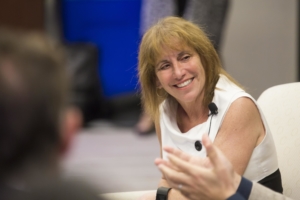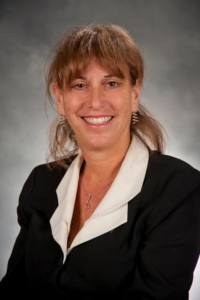
Andrea Hershatter is Senior Associate Dean of Undergraduate Education at Emory University’s Goizueta Business School. Photo courtesy of Goizueta Business School
As dean of the undergraduate business program at Emory University, Andrea Hershatter has become a master of riding the tide. When it comes to the evolution of the business school — and business education as a whole — she’s seen and experienced a lot. In 1988 when she first arrived, the school hadn’t even been named Goizueta Business School yet. What’s more, the idea of “co-curricular” activities for undergraduate students wasn’t nearly as meaningful as it is today. And technology? Let’s just say technology wasn’t the thin line between keeping up or falling behind.
Thirty years later, Goizueta is celebrating the 25th anniversary of its naming and a centennial commemoration of the school’s founding is just around the corner in 2019. A two-year program that is ranked among the top 15 in Poets&Quants’ Best Undergraduate Business Programs, Goizueta undergrad is best known for requiring all students to first spend two years immersed in liberal arts before entering into the business school. Though a differentiator, Hershatter also attributes this rule to Goizueta’s exceptionally high — 80% — acceptance rate.
“Everybody who is good enough to get into Emory at the front end has the capacity to come into the business school,” she says.
In an in-depth interview, Hershatter gives Poets&Quants the dish on a highly intense review of the business curriculum that’s currently underway, what has her most excited about being a part of the business school right now, and how best to prepare students for the ever-changing, ever-evolving business world. Hint: it has nothing to do with hitting the ground running the first day on the job.
P&Q: What makes the undergraduate business experience at Goizueta unique?
Hershatter: First of all, for students it starts with choosing the university. For us, that is particularly relevant because they start in the college. Nobody is pre-admitted or pre-committing to the business school. Emory has an outstanding reputation for liberal arts and we’re in a wonderful and vibrant city. There’s so much going on here from a business perspective. We bring all the strengths of the university — one of the world’s finest creative departments all the way to our strengths in medicine and having the Center for Disease Control on campus. Part of it starts there.

Andrea Hershatter joined the business school at Emory University in 1988 then became dean of Goizueta’s undergraduate program in the mid 1990s. She also teaches entrepreneurship courses at the school. Photo courtesy of Goizueta Business School
Within the business school there are probably three or four things that distinguish us. Most notably first is our interconnection with liberal arts. I love that our faculty are now calling it the double helix and about a quarter of our students complete other majors in liberal arts.
Our size and internal communal interaction is also very compelling for a lot of students. We graduate about 400 students a year. It’s not so small that it doesn’t’ have scope and range, but not so big that you lose the personal approach. This is very much felt in the interaction between students and between faculty and students to get involved in activities and take on leadership roles.
Another thing that makes the experience unique is that a little over a quarter of our students study abroad. But it’s body-to-body. For every student we send abroad, we get a student from the school where we’re sending them. Each year 100 or so students come to us from the world’s best business schools.
What’s Goizueta’s trademark in a crowded B-school market?
While liberal arts is a very strong piece of who we are, I believe the defining experience of this BBA program is that it is structured to prepare you for as narrow or as broad a set of expertise as any student desires. That is partially about integration with liberal arts, but also if you want to go into finance, we probably have 25 electives in finance. There are no doctoral students teaching. The same professors who teach in the MBA program also teach our BBAs. If a student wants to get very focused on a specific functional field, they’ll find incredible strengths amongst our faculty in that program.
How has business education evolved since you’ve been in the business school?
It used to be enough to be a functional expert in a particular field. Now, we as business schools have to have individual electives and cross-cutting curricular themes to prepare students for a dynamic, evolving world. Things have moved beyond function and industry to acquiring skills and knowledge to apply in interesting ways across a variety of functions and industries throughout students’ careers.
The second way it’s changed is the increase in co-curricular objectives. There was no such thing when I was in undergrad. We now spend as much time with our students and they spend as much time engaged with us in things that happen outside the classroom as inside. Leadership development, professional training, opportunities to work on an applied practicum, something experiential, a service-based project, a study abroad experience. All undergrad programs think very carefully about training students as whole people — not just about giving them exposure to particular courses and knowledge. But, I want to be careful in saying this because I don’t think that part goes away. It remains a key component to undergraduate business education.
How have students changed over the years?
You’re talking to someone who’s spent a lot of time consulting on and lecturing about millennials. Of course I’ve seen changes. Over time, I think the shift from a Gen X population to a Millennial population has been along two important lines. First, as technology develops, it’s absolutely the case that they expect and need us to be on the cutting edge, providing them with not only access to the most advanced technology for use in business, but also with an understanding of how to appropriately leverage its advantages.
Secondly, this generation was raised by a population across all socioeconomic categories. With it comes a population of parents willing to expend increasing percentages to provide sons and daughters with access to the best education, opportunities, and exposure they can afford to provide. The reason has to do with the parental sense — which is true — that our grads are being asked to navigate a messy world with big, complicated problems. So every tool we give them matters.
If I’m a parent investing all this time, money, and energy, then I am not a passive consumer. We’ve seen parents being very, very involved from preschool all the way through college. Parents who say to us, ‘I’ve held them to this standard and here’s’ what I need you, the school, to do to maximize their potential.’
Our response to the students is, ‘We are only as good as you are. We’re relying on you, our students, to drive us forward, tell us what you need to excel here, and how to make you the most effective graduates we possibly can.’ And we mean it. That message comes with a huge benefit to the schools in that students, faculty, staff, and sometimes parents are active participants in the process of growing and evolving and preparing that student. But it also comes with very high expectations from students and family on what the school will provide — opportunities, networks, infrastructure, and more — in order to ensure they have every possible opportunity to excel.











Questions about this article? Email us or leave a comment below.